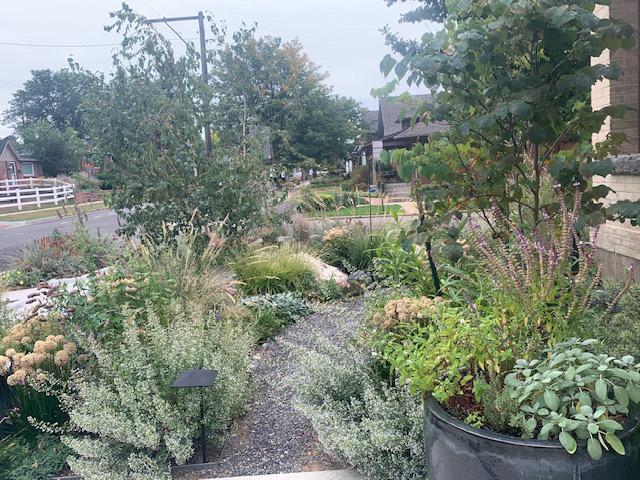By Deb Lebow Aal
One of the biggest challenges we face as native plant gardeners is how to design a native plant garden. After all, we are challenging the norm. We are not planting an expanse of turf with two trees plopped in somewhere. We are changing the way we landscape on the Front Range to mimic nature’s “norms.” But, what are our choices with native plants?

You have many choices. Many like a manicured look, and that is quite possible with native plants. You can draw up a plan for a formal-looking garden. Or you can design a prairie garden, mimicking what nature does, or did, here. Or you can have a “chaos garden,” where you plant as you go with no master plan whatsoever. And there’s everything in between. You can do a combination of the three and see which suits you best.
I am no expert on designing a landscape. My landscape is a little like the shoemaker’s children who have no shoes. I don’t have time to do what I want to make my garden look the way I’d like it to look. But, to me, it’s about the function of the landscape and the “ecosystem services” it provides. How is it benefitting the ecosystem or biota? How many insects do I see buzzing around? If it’s bustling like LaGuardia Airport on Thanksgiving, we’re good.
If, however, we want to attract more people to sustainable, native plant gardening, garden design also has to also be aesthetically pleasing. Here are a few steps you can take.
Decide What Look You Want
If just starting out, get a sense of different “looks and feels” of native gardens in your area before deciding. I suggest going to Chatfield to see the native gardens there. Or, take a look at a few of the Wild Ones’ Front Range demo gardens: Greenverein (a very urban tree strip, also know as a “hell strip,” at the corner of 16th and Clarkson in Denver); Depot Prairie; and the soon to be planted Ekar Farm (6825 E. Alameda Ave). You can also find organized yard and garden tours.
Advantages/Disadvantages of Each
A formal look will require a lot more care. Many, if not most, of our native plants self-seed, so if you like a very manicured look, you will be editing plants out quite a bit. But, it’s still doable. If you like a prairie look, you will not have as much work down the road. You will have to be diligent about weeding for the first few years, but once the plants take, they should crowd out the weeds. And, chaos gardening – which is what I have – requires endless thinking because you (I) are (am) constantly changing things around.


Design Tips
Our very own Kenton Seth of Paintbrush Gardens has designed a sample native plant garden for the Front Range. It is beyond comprehensive. He has a number of tips for the sustainable gardener, and we are very much the richer for his work, including his sample garden plan for the Front Range. We will be highlighting Kenton’s design and tips in future Wild Ones Front Range events, so stay tuned. In his recent article in the Colorado Gardener (Harvest 2021), Kenton writes about there being three kinds of gardens: mineral mulch gardens (mimicking desert conditions); organic gardens (wood chips and mulch, mimicking forest conditions); and living mulch gardens (mimicking prairies).

Here are a few “things to think about” from Kenton’s sample garden plan:
- Areas where you will not irrigate at all: (beyond when the plants are establishing). Think about an area you will not be irrigating at all. This area can be your gravel mulch area. Kenton designed the whole front yard to be un-irrigated in the sample plan and has a list of which plants will do well there. These gravel-mulched areas require plants that like lean soils, as you will not be amending with living mulch.
- Long-term maintenance: Think about maintenance as you plant and decide early which areas will be which. If you place them correctly (e.g., living mulch areas next to and under trees; mineral mulch areas far from trees), you will have less maintenance.
- No exporting of organic materials. Use everything you can in your landscape rather than exporting to the trash or compost bin. If you employ a chop and drop system, you will avoid many garden chores many of us dislike, like hauling away dead material only to haul material back later as mulch. Kenton talks about a system for tall grasses. When cutting grasses back in early spring, he cuts 2-4 inch inch pieces and drops them around the plants as living mulch. Apparently, larger grass pieces blow away more easily than the small pieces (rather counter-intuitive, I thought). It is a very good idea to think about and limit your future garden maintenance chore time. Your future self will thank you!
- Plant in Drifts. Clumps, swaths, drifts, or concentrations of the same plants attract pollinators and makes it easier for them to do their thing. As you think about your drifts, think also about bloom times, making sure you have something blooming throughout the season.
Design away! And, have fun. Just remember your purpose is to contribute to an ecosystem that is supporting your local food web. Try to balance aesthetics with ecosystem services, and try not to fight with mother nature. Work with her – she usually wins.
Curious to learn more about transforming your garden into a habitat with Colorado native wildflowers, grasses, shrubs, and trees? Check out our native gardening toolkit, register for an upcoming event, subscribe to our newsletter, and/or become a member – if you’re not one already!
